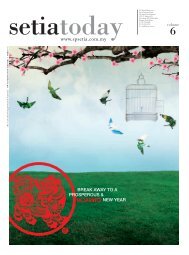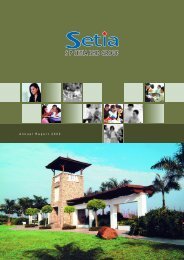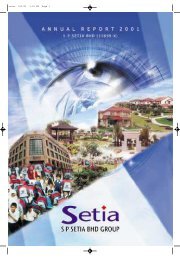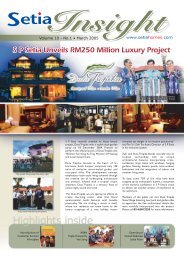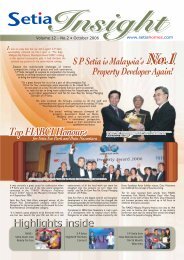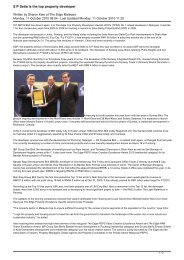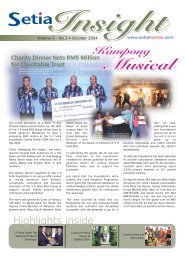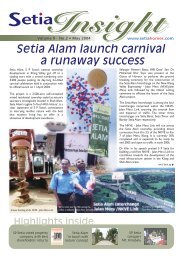Change - S P Setia Berhad
Change - S P Setia Berhad
Change - S P Setia Berhad
You also want an ePaper? Increase the reach of your titles
YUMPU automatically turns print PDFs into web optimized ePapers that Google loves.
83<br />
S P <strong>Setia</strong> <strong>Berhad</strong> Group<br />
NOTES TO THE FINANCIAL STATEMENTS<br />
FOR THE YEAR ENDED 31 OCTOBER 2008<br />
1. SIGNIFICANT ACCOUNTING POLICIES (cont’d)<br />
(d)<br />
Significant accounting judgements and estimates (cont’d)<br />
(i)<br />
Critical judgement made in applying accounting policies (cont’d)<br />
Classification between investment properties and owner-occupied properties<br />
The Group determines whether a property qualifies as an investment property, and has developed certain criteria based<br />
on FRS 140 in making that judgement.<br />
In making its judgement, the Group considers whether a property generates cash flows largely independently of other<br />
assets held by the Group. Owner-occupied properties generate cash flows that are attributable not only to the property,<br />
but also to other assets used in the production or supply process.<br />
Some properties comprise a portion that is held to earn rental or for capital appreciation and another portion that is<br />
held for use in the production or supply of goods and services or for administrative purposes.<br />
If these portions could be sold separately (or leased out separately under a finance lease), the Group accounts for the<br />
portions separately.<br />
If the portions could not be sold separately, the property is accounted for as an investment property only if an insignificant<br />
portion is held for use in the production and supply of goods and services or for administrative purposes.<br />
Judgement is made on an individual property basis to determine whether ancillary services are so significant that a<br />
property does not qualify as investment property.<br />
Revenue recognition of property development activities and construction contracts<br />
The Group recognises property development activities and construction contracts based on the percentage of<br />
completion method. The stage of completion of the property development activities and construction contracts is<br />
measured in accordance with the accounting policies set out in (n) and (o) below.<br />
Significant judgement is required in determining the percentage of completion, the extent of the development project and<br />
contract costs incurred, the estimated total revenue and total costs and the recoverability of the development project<br />
and contract. In making these judgements, management relies on past experience and the work of specialists.<br />
(ii)<br />
Key sources of estimation uncertainty<br />
The key assumptions concerning the future and other key sources associated with estimation uncertainty at the balance<br />
sheet date that have a significant risk of causing a material adjustment to the carrying amounts of assets and liabilities<br />
within the next financial period are discussed below:<br />
Depreciation of property, plant and equipment and investment properties<br />
Property, plant and equipment and investment properties are depreciated on a straight-line basis to write off their costs<br />
to their residual values over their estimated useful lives. Management estimates the useful lives of these assets to be<br />
within 3 to 50 years for property, plant and equipment and 50 to 96 years for investment properties.<br />
The carrying amounts of the Group’s and Company’s property, plant and equipment as at 31 October 2008 were<br />
RM80,226,000 and RM200,000 (2007 : RM63,185,000 and RM278,000), respectively.<br />
The carrying amounts of the Group’s and Company’s investment properties as at 31 October 2008 were RM167,931,000<br />
and RM1,157,000 (2007 : RM95,032,000 and RM1,552,000), respectively.<br />
<strong>Change</strong>s in the expected level of usage, physical wear and tear and technological development could impact the<br />
economic useful lives and residual values of these assets, and therefore future depreciation charges could be revised.





